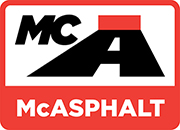ASPHALT EMULSIONS
McAsphalt’s asphalt emulsions have a wide variety of applications, from tile adhesives to vehicle undercoating.
Asphalt emulsions are manufactured by milling asphalt cement (bitumen) into microscopic particles and dispersing them in water using a chemical emulsifier. The tiny droplets of asphalt remain uniformly suspended until the emulsion is used.
The chemistry of the asphalt emulsion determines the stability of the system. When emulsions are used in the field, the system will at one point become unstable and cause the asphalt and water suspension to shift. This causes the water to evaporate, leaving behind residual asphalt that coats and bonds to aggregates when used during a road application.
McAsphalt’s asphalt emulsions have a wide variety of applications, from tile adhesives to vehicle undercoating. The primary uses are tailored toward roads, including seal coating, recycling and slurry systems.
Chemical surface-active agents, which serve as emulsifiers, are classified by the electrochemical charge that is attained when they dissociate in a water solution. In the case of anionic emulsions, the chemical charge is negative.
Chemical surface-active agents, which serve as emulsifiers, are classified by the electrochemical charge that is attained when they dissociate in a water solution. In the case of cationic emulsions, the chemical charge is positive.
Chemical surface-active agents, which serve as emulsifiers, are classified by the electrochemical charge that is attained when they dissociate in the water solution. In the case of high-float emulsions, the chemical charge is negative.
McAsphalt’s expertise in emulsion modification and our state-of-the-art terminals allow us to custom blend emulsified petroleum and non-oil-based products for many road- and non-road-related industries.
Polymer-Modified Asphalt Emulsions
Our polymer-modified asphalt emulsions provide increased service life and cost savings; they can be used in applications that have been unsuited to conventional asphalt emulsions or cutbacks.
